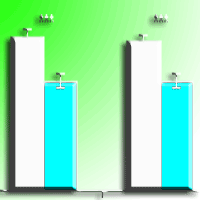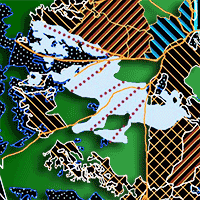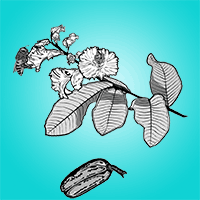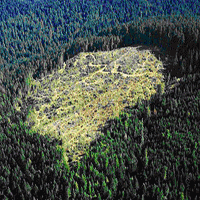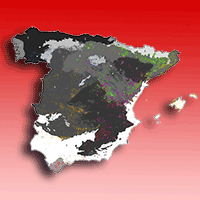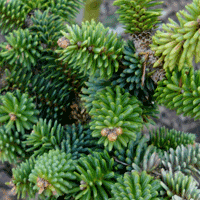
Regeneration of Abies pinsapo within gaps created by Heterobasidion annosum-induced tree mortality in southern Spain
Rafael M Navarro-Cerrillo (1) , J Julio Camarero (2), Rubén D Manzanedo (1), Rafael Sánchez-Cuesta (1), José Lopez Quintanilla (3), Raul Sánchez Salguero (1)
iForest - Biogeosciences and Forestry, Volume 7, Issue 4, Pages 209-215 (2014)
doi: https://doi.org/10.3832/ifor0961-007
Published: Feb 27, 2014 - Copyright © 2014 SISEF
Research Articles
Abstract
We explored the effects of tree-fall gaps caused by Heterobasidion annosum-induced tree death on the regeneration of the relict Abies pinsapo in southern Spain. We analyzed the structure and regeneration of A. pinsapo in 44 circular closed-canopy plots and 11 gaps (mean size 75 m2) located in H. annosum infection foci. We measured adult density, basal area, and height of all tree species with a diameter at breast height greater than 7.5 cm and quantified regeneration abundance. Diameter structures were analyzed using Weibull functions. A. pinsapo comprised 49-81% of total adult tree density (358-1418 trees ha-1) and total basal area (15.70-39.22 m2 ha-1). Density of A. pinsapo juveniles ranged from 129 to 416 individuals ha-1, while that of juveniles of other tree species such as Quercus ilex was much lower. A. pinsapo saplings and seedlings were more abundant within gaps than in closed-canopy sites. A. pinsapo regeneration was related to the tree species composition of the stands adjacent to gaps. The main potential species replacing A. pinsapo in H. annosum-induced gaps were, in decreasing order of importance, Quercus ilex, Q. faginea, and Juniperus oxycedrus. The current stand structure and gap-infilling processes suggest that A. pinsapo regenerates adequately within H. annosum-induced gaps. However, the relative proportion of other coexisting tree species within H. annosum-related gaps will increase substantially over time as compared with closed-canopy areas.
Keywords
Abies pinsapo, Mediterranean Forests, Forest Management, Gaps, Regeneration
Authors’ Info
Authors’ address
Rubén D Manzanedo
Rafael Sánchez-Cuesta
Raul Sánchez Salguero
Dept. Ingeniería Forestal, DendrodatLab, Universidad de Córdoba, Campus de Rabanales, Ctra. IV km. 396, E-14071 Cordoba (Spain)
ARAID, Instituto Pirenaico de Ecología (CSIC), Avda. Montañana 1005, E-50080 Zaragoza (Spain)
Consejería de Medio Ambiente, Junta de Andalucia, Sevilla (Spain)
Corresponding author
Paper Info
Citation
Navarro-Cerrillo RM, Camarero JJ, Manzanedo RD, Sánchez-Cuesta R, Lopez Quintanilla J, Sánchez Salguero R (2014). Regeneration of Abies pinsapo within gaps created by Heterobasidion annosum-induced tree mortality in southern Spain. iForest 7: 209-215. - doi: 10.3832/ifor0961-007
Academic Editor
Renzo Motta
Paper history
Received: Jan 31, 2013
Accepted: Nov 18, 2013
First online: Feb 27, 2014
Publication Date: Aug 01, 2014
Publication Time: 3.37 months
Copyright Information
© SISEF - The Italian Society of Silviculture and Forest Ecology 2014
Open Access
This article is distributed under the terms of the Creative Commons Attribution-Non Commercial 4.0 International (https://creativecommons.org/licenses/by-nc/4.0/), which permits unrestricted use, distribution, and reproduction in any medium, provided you give appropriate credit to the original author(s) and the source, provide a link to the Creative Commons license, and indicate if changes were made.
Web Metrics
Breakdown by View Type
Article Usage
Total Article Views: 55106
(from publication date up to now)
Breakdown by View Type
HTML Page Views: 45980
Abstract Page Views: 3625
PDF Downloads: 4043
Citation/Reference Downloads: 23
XML Downloads: 1435
Web Metrics
Days since publication: 4317
Overall contacts: 55106
Avg. contacts per week: 89.35
Citation Metrics
Article Citations
Article citations are based on data periodically collected from the Clarivate Web of Science web site
(last update: Mar 2025)
Total number of cites (since 2014): 15
Average cites per year: 1.25
Publication Metrics
by Dimensions ©
Articles citing this article
List of the papers citing this article based on CrossRef Cited-by.
References
Factors influencing sapling composition in canopy gaps of a temperate deciduous forest. Plant Ecology 120: 21-32
Gscholar
Past and present potential distribution of the Iberian Abies species: a phytogeographic approach using fossil pollen data and species distribution models. Diversity and Distribution 16: 214-228.
CrossRef | Gscholar
Biología del pinsapo. Consejería de Medio Ambiente, Sevilla, Spain. [in Spanish]
Gscholar
Performance of percentile based diameter distribution prediction and Weibull method in independent data sets. Silva Fennica 34: 381-398.
Gscholar
Censo de focos de Heterobasidion annosum (Fr.) Bref. en ecosistemas de pinsapo [Census outbreaks of Heterobasidion annosum (Fr.) Bref. in A. pinsapo ecosystems]. Boletin de Sanidad Vegetal y Plagas 29: 581-92. [in Spanish]
Gscholar
Restauración del pinsapo (Abies pinsapo Boiss.) en Andalucía. In: “Pinsapares de Andalucía” (López, J, Navarro-Cerrillo RM, Carreira J eds). Consejería de Medio Ambiente, Sevilla, Spain, pp. 152-187. [in Spanish]
Gscholar
Forest stand dynamics. John Wiley & Sons, Inc., New York, USA, pp. 145.
Gscholar
Ecology of Mediterranean evergreen oak forests. Ecological Series vol. 137, Springer, Berlin, Germany, pp. 373.
Gscholar
Disturbance regimes in temperate forests. In: “The Ecology of Natural Disturbance and Patch Dynamics” (Pickett ST, White PS eds). Academic Press, Orlando, FL, USA, pp. 17-33.
Gscholar
Regeneration dynamics. In: “Plant Succession: Theory and Prediction” (Glenn-Lewin D, Peet R eds). Chapman and Hall, London, UK, pp. 152-187.
Gscholar

